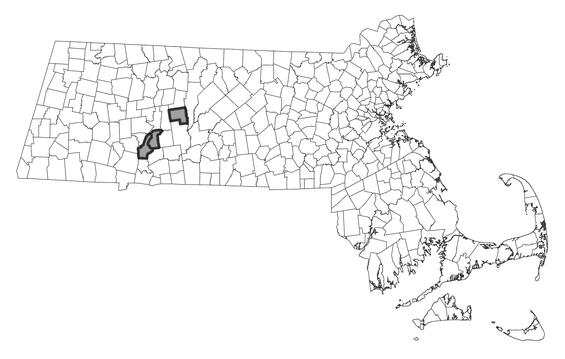- Scientific name: Carex glaucodea
- Species of Greatest Conservation Need (MA State Wildlife Action Plan)
- Endangered (MA Endangered Species Act)
Description
Glaucescent sedge, a member of the sedge family (Cyperaceae), is a perennial, herbaceous, grass-like plant of rich, oak-hickory or hickory-hop hornbeam woodlands. It is a pale plant that grows in loose clumps of thick, leathery basal leaves with flowering stems up to two feet (6 dm) tall. Edward Tuckerman, of Amherst College, first described this taxon in the 1860’s as a variety of flaccid sedge (Carex flaccosperma). The common name and specific epithet are derived from the glaucous, or whitish, cast of its leaves.
To correctly identify the glaucescent sedge and other members of the genus Carex, a technical manual should be consulted. Species in this genus have tiny, wind-pollinated flowers that are borne in spikes. Each flower is unisexual, and is closely subtended by small, flat scales that largely conceal the flowers. The staminate (i.e., pollen bearing) flowers are subtended by a single scale (staminate scales). The pistillate (i.e., ovule bearing) flowers are subtended by two scales, an outer flat scale (pistillate scale) and an inner, sac-like scale, called a “perigynium,” that encloses the flower, and later, the fruit.
Glaucescent sedge belongs to a group of Carex (section Grisaea), which all have impressed (sunken) perigynia veins. Its leaves are glaucous and relatively wide (0.4-1 cm; 0.2 -0.4 in). Two characters of the perigynia—the absence of slender prolonged tips known as “beaks,” and the presence of impressed veins—help distinguish this sedge from other glaucous-leaved sedges. Each flowering culm produces a single, terminal staminate spike, which is stalkless or short-stalked, above two to four pistillate spikes. The bracts (leaf-like structures below the spikes) are long, extending beyond the tops of the spikes. There are several superficially similar species with relatively wide, glaucous to blue-green leaves found in rich woods, such as white bear sedge (C. albursina), broad-leaved woodland sedge (C. platyphylla), concealed sedge (C. abscondita), spreading woodland sedge (C. laxiculmis), and loose-flowered woodland sedge (C. laxiflora). The glaucescent sedge may be distinguished from these sedges using the following combination of characters: leaves 1 cm [0.4 in] or less wide (to distinguish from the broader-leaved C. albursina and C. platyphylla); flowering culm length similar to leaf length (eliminates C. abscondita); and impressed veins on densely-clustered perigynia (rules out C. laxiculmis and C. laxiflora).
Population status
Glaucescent sedge is listed under the Massachusetts Endangered Species Act as Endangered. All listed species are protected from killing, collecting, possessing, or sale and from activities that would destroy habitat and thus directly or indirectly cause mortality or disrupt critical behaviors. The plant is currently restricted to the Metacomet Range in Massachusetts (but was historically collected from the Blue Hills as well) where mineral-rich, neutral soils are found. Glaucescent sedge is also considered to be rare in New York and was present historically in New Hampshire. The MassWildlife’s Natural Heritage & Endangered Species Program database has 6 records from 3 counties: Hampden, Hampshire, and Norfolk. 5 of these records have been observed within the last 25 years.
Distribution and abundance
The documented range of glaucescent sedge extends from New Hampshire, Massachusetts and southern Ontario to southern Indiana and Missouri, and south to North Carolina and Arkansas. The documented range of glaucescent sedge extends from New Hampshire, Massachusetts and southern Ontario to southern Indiana and Missouri, and south to North Carolina and Arkansas.

Distribution in Massachusetts
1999-2024
Based on records in the Natural Heritage Database
Habitat
Glaucescent sedge is a plant of rich, seasonally mesic to dry woodlands and associated clearings, usually over basalt traprock ridges in Massachusetts. It colonizes recently disturbed, open to semi-open sites and is seldom seen in deep woods where there is heavy shade or leaf litter. Natural habitat is exposed soil or moist circumneutral rock in forests adjacent to ephemeral mountain creeks. Secondary roads, trails and other disturbances in the vicinity of natural habitat can result in dense colonies becoming established. Among the plant species associated with glaucescent sedge are woodland sunflower (Helianthus divaricatus), white wood aster (Eurybia divaricata), deerberry (Vaccinium stamineum), various sedges (Carex spp.), goldenrods (Solidago spp.), hickories (Carya spp.), and oaks (Quercus spp.), including the northern red oak (Quercus rubra) and white oak (Q. alba), and hop-hornbeam (Ostrya virginiana). Violet wood-sorrel (Oxalis violacea), a Threatened Massachusetts plant, has been found growing with glaucescent sedge.
Healthy habitats are vital for supporting native wildlife and plants. Explore habitats and learn about conservation and restoration in Massachusetts.
Threats
Succession and invasive plants are likely the biggest threats to glaucescent sedge.
Conservation
The habitat preference of glaucescent sedge for areas along trails or roadbeds suggests that, at least in Massachusetts, canopy openings and minor soil disturbances benefit the plant. However, disturbances do make it much easier for aggressive exotic plants to invade any area and possibly out-compete native species. Weedy alien species have been noted at one of the current stations of glaucescent sedge.
Contact
| Date published: | April 9, 2025 |
|---|